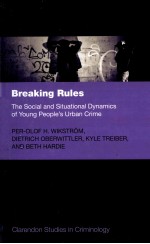
- 作 者:PER-OLOF H.WIKSTROM
- 出 版 社:OXFORD UNIVERSITY PRESS
- 出版年份:2012
- ISBN:0199592845
- 标注页数:479 页
- PDF页数:509 页
请阅读订购服务说明与试读!
订购服务说明
1、本站所有的书默认都是PDF格式,该格式图书只能阅读和打印,不能再次编辑。
2、除分上下册或者多册的情况下,一般PDF页数一定要大于标注页数才建议下单购买。【本资源509 ≥479页】
图书下载及付费说明
1、所有的电子图书为PDF格式,支持电脑、手机、平板等各类电子设备阅读;可以任意拷贝文件到不同的阅读设备里进行阅读。
2、电子图书在提交订单后一般半小时内处理完成,最晚48小时内处理完成。(非工作日购买会延迟)
3、所有的电子图书都是原书直接扫描方式制作而成。
Part 1 Analysing Crime as Situational Action: Theory, Methods, Key Constructs, and Basic Findings 3
1. Situational Action Theory 3
1.1 Criminology: A fragmented and poorly integrated discipline 3
1.2 Key common shortcomings in criminological theory 7
1.3 Situational Action Theory: Basic constructs and propositions 11
1.4 Situational Action Theory: The causes of the causes 29
1.5 Explaining urban crime patterns 41
2. The Peterborough Adolescent and Young Adult Development Study 44
2.1 The research design 44
2.2 The cohort study 53
2.3 Parents' interviews 61
2.4 Young people's interviews 62
2.5 Space-time budget 67
2.6 Criminal justice records data 78
2.7 Data quality 82
2.8 Small area community survey (PCS) 87
2.9 Summary and conclusion 104
3. Young People's Crime, Crime Propensity, and Criminogenic Exposure: Key Constructs and Basic Findings 107
3.1 Crime 107
3.2 Crime propensity 132
3.3 Criminogenic exposure 141
3.4 Predicting crime involvement: The interaction between crime propensity and criminogenic exposure 155
3.5 Summary and conclusion 155
Part 2 The Social Dynamics of Young People's Urban Crime 161
4. Peterborough, Its Urban Structure, and Crime 161
4.1 Peterborough: The research site 162
4.2 Land use 167
4.3 Residential segregation 171
4.4 Area patterns of crime and disorder 186
4.5 Modelling population structure, collective efficacy, land use, and crime events 200
4.6 Summary and conclusion 206
5. Young Offenders and Their Crimes in the Urban Environment 209
5.1 Area patterns of young people's crime 211
5.2 Modelling the distribution of young people's crime 219
5.3 Offender home locations 222
5.4 Modelling the distribution of young offenders 236
5.5 Crime and distance 239
5.6 Summary and conclusion 250
6. Young People, Their Activities, and Criminogenic Exposure 252
6.1 Young people's activity patterns 252
6.2 Settings and circumstances of criminogenic exposure 277
6.3 Social sources of young people's criminogenic exposure 299
6.4 Differential effects of criminogenic exposure by young people's crime propensity 311
6.5 Explaining the variation in area concentrations of young people's crime 312
6.6 Summary and conclusion 319
Part 3 The Situational Dynamics of Young People's Crime 323
7. The Crime Convergence: Kinds of People in Kinds of Settings 323
7.1 Studying the intersection of people and settings 323
7.2 Distribution of space-time budget crimes 323
7.3 Exposure to criminogenic settings and crime involvement by crime propensity 347
7.4 Summary and conclusions 363
8. Choosing Crime as an Alternative: Crime Propensity, The Perception-Choice Process, and Crime 364
8.1 Capturing the perception-choice process: A factorial survey approach 367
8.2 PADS+ randomized scenarios 369
8.3 Scenario findings 380
8.4 Hypothetical scenarios and the real world 393
8.5 Summary and conclusion 402
Part 4 The Dynamics of Rule-Breaking: Key Findings 405
9. It's All About Interactions 405
9.1 Breaking rules 405
9.2 It's all about interactions 406
Appendices 411
A1 Technical Appendix 413
A1.1 Calculating distance 413
A1.2 Presentation of spatial data 413
A1.3 Controlling for resident young people 419
A1.4 Quantifying time use 421
A2 Space-Time Budget Coding Appendix 423
A2.1 Activity 424
A2.2 Place 427
A2.3 With whom 430
A2.4 Extra incidents 433
References 437
Index 467
